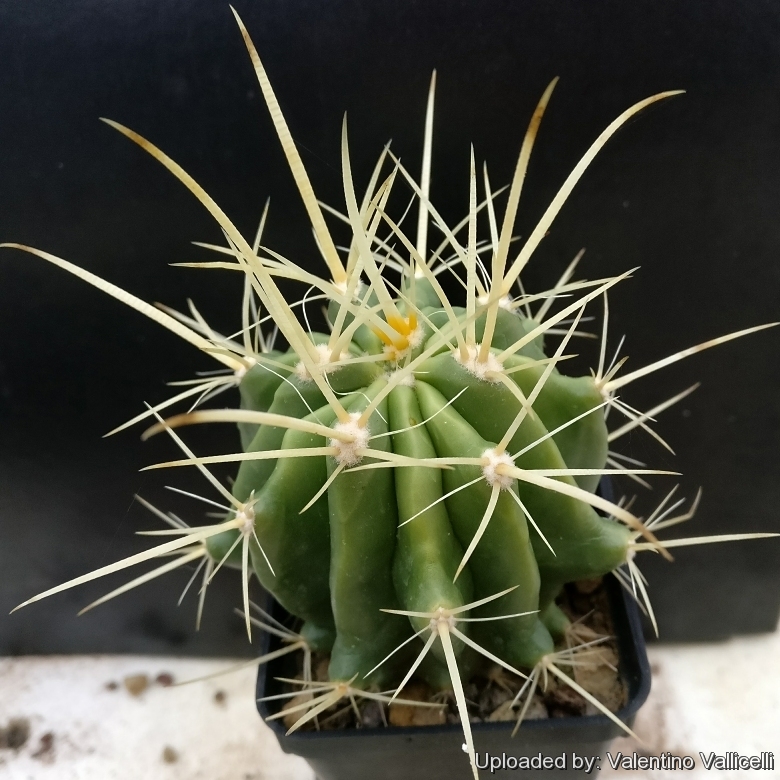Accepted Scientific Name: Ferocactus pilosus (Galeotti ex Salm-Dyck) Werderm.
Repert. Spec. Nov. Regni Veg. Sonderbeih. C t. 72. 1933

Ferocactus stainesii f. albispinum Photo by: Valentino Vallicelli
Origin and Habitat: Garden origin. The natural species, Ferocactus stainesiiSN|13424]]SN|13428]] is the Mexican form of Ferocactus pilosusSN|13428]]SN|13424]], where it occurs in the states of Coahuila, Durango, Nuevo León, San Luis Potosí, Tamaulipas, and Zacatecas.
Synonyms:
See all synonyms of Ferocactus pilosus
back
Accepted name in llifle Database:Ferocactus pilosus (Galeotti ex Salm-Dyck) Werderm.Repert. Spec. Nov. Regni Veg. Sonderbeih. C t. 72. 1933Synonymy: 18
back
Description: Ferocactus stainesii f. albispinumSN|13428]]SN|33264]] is an undescribed name (n.n.) used in some catalogue to describe a morphological form of Ferocactus stainesiiSN|13424]]SN|13428]] The mexican form of Ferocactus pilosusSN|13428]]SN|13424]]). This peculiar plant can be easily tell apart from standard Ferocactus stainesiiSN|33264]]SN|13428]] for its creamy-white spines (not red). It is usually a simple barrel/column cactus.
In habitat plants must be a great age, some-times forming into quite massive groups, with several subsidiary barrels growing from the main one, with deep green bodies densely covered with bright red spines up its entire length.
Cultivation and Propagation: Ferocactus stainesii f. albispinumSN|33264]]SN|33264]] is quite resistant to cultivation. The only things that can kill this plant are cold and overwaterin. Nevertheless, it is appropriate to provide adequate growing conditions in order to obtain compact plant with dense spine cove.
Growth rate: Slow growing to start but does well under cultivation. They need to be moderately large (about 20 cm in diameter) before they flower.
Soils: Use a an open and free draining mineral compost with little organic matter (peat, humus) that allows therefore roots to breath (as it is rot prone).
Repotting: Repot every 2-3 years.
Watering: It likes a winter's rest and should be kept completely dry during the winter months. From early spring onwards the plant will begin to grow and watering should be increased gradually until late spring when the plant should be in full growth. Water regularly during the aestival growth cycle so long as the plant pot is allowed to drain and not sit in a tray of water (this plant need plenty of water) But needs to be avoided wetting the bodies of these plants while they are in sunlight. A wet cactus in the sun light can cause sun burning which can lead to scars or even fungal infections and death. From late summer watering should be reduced to force the plant to go in to a state of semi dormancy, by autumn you should be back in to the winter watering regime. Keep dry with ample airflow in winter (but for outdoors cultivation it is somewat resistant to wet conditions, too if grown in very draining subtrata). In the rest period no high atmospheric humidity!! Care must be taken with watering as they tends to become swollen and untidy in growth habit if given too much water and shade.
Fertilization: Feed with a high potassium fertilizer in summer.
Hardiness: Keep dry at 5- 10° C in winter, but can tolerate sporadic light frost if kept on the dry side prior to, and during, cold weather.
Exposition: The plant tolerates very bright situations, if kept too dark they may become overly lush and greener and could be prone to rotting due to over watering. Strong light encourages flowering and heavy wool and spine production, but is likely to suffer from sun scorch or stunted growth if over exposed to direct sunlight during the hottest part of the day in summer. .
Propagation: Seeds are the only way of reproducing. Seeds (no dormancy requirement) germinate in 7-14 days at 21-27° C in spring), remove gradually the glass cover as soon the plants will be well rooted (ca 1-2 weeks) and keep ventilated, no full sun for young plants! The seedlings should not be disturbed until they are well rooted, after which they can be planted separately in small pots.










